Fig. 5.1
Most common laboratory changes after intensive exercise
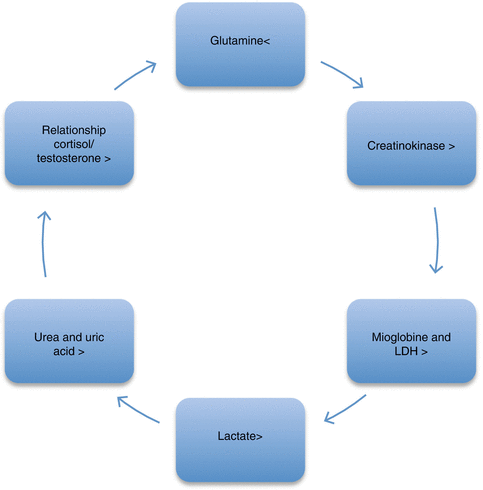
Fig. 5.2
Blood parameters and its modifications after vigorous exercise
Table 5.1
Immunological and biochemical markers associated with overtraining
Leucocyte responses to antigens (e.g. lymphocyte proliferation, neutrophil degranulation, NK cytotoxic activity) |
Salivary IgA |
Neutrophil/lymphocyte ratio• T-cell CD4+/CD8+ Ratio• T-cell CD4 + CD45RO+ expression |
Plasma cortisol or cortisol/testosterone ratio |
Urinary steroids or catecholamines |
Plasma glutamine |
Plasma urea |
Plasma cytokines (e.g. IL-6) |
Blood lactate response to incremental or high-intensity exercise |
Plasma or salivary cortisol response to high-intensity exercise |
Table 5.2
Individual monitoring: a suggested battery of tests to detect impending overtraining
Performance |
Mood state questionnaires |
Diary of responses to training (fatigue, muscle soreness) and symptoms of illness |
Sleeping heart rate |
Blood lactate and plasma cortisol response to high-intensity or incremental exercise |
Plasma creatine kinase activity |
Cortisol to testosterone ratio |
Nocturnal urinary noradrenaline and adrenaline secretion |
Routine haematology (blood haemoglobin, serum ferritin, leucocyte counts) |
T-lymphocyte CD4+/CD45RO+ expression |
Experience of coach and athlete |
5.3.2 Omegawave Test: One More Tool to Understand Fatigue and Overtraining
Omegawave device can help, in association with other factors, identify limiting factors for CNS and cardiac and metabolic systems. Omegawave’s measures can be adjusted to validate training approach and assess the functional readiness of athletes, with the aim of identifying the optimal types and intensities of training and recovery, to improve athletic performance and help avoid injury. It takes measurements relevant to an athletes’ physiological condition, including ECG, Omega (DC potential of the brain), neuromuscular and reaction rate measurements, for analysis. Measurements and their results can be taken for a whole team and viewed by a coach locally or remotely. The measurements are processed by Omegawave’s patented cloud-based system to give results and recommendations that the company claims are relevant to the athlete’s cardiac readiness (Fig. 5.3), metabolic readiness, central nervous system readiness, gas exchange readiness, detoxification readiness and hormonal system readiness (Fig. 5.4) in the so-called omegametry (electrophysiological padronised values that provide information about physical surcharge).
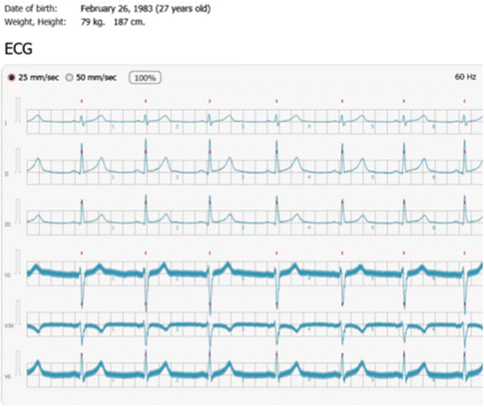
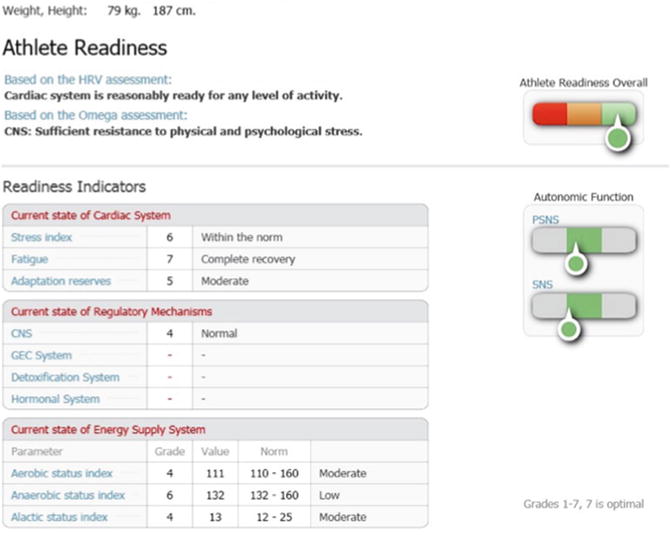

Fig. 5.3
Normal presentation of cardiac evaluation by Omegawave device

Fig. 5.4
Normal tracing of athlete readiness in Omegawave device
Rooted in Russian sports science and space medicine, Omegawave technology was developed in the USA. Its patented technology was originally based on physiological data from 10,000 high-performing athletes and has been validated in countless studies conducted by sports and research institutes worldwide.
Unlike the traditional stress test, known as the VO2Max or treadmill test, the Omegawave system takes readings of athletes during times of rest or relaxation. The idea is to measure how quickly athletes are recovering from workouts, competition and other stress [2].
Based on regular readings of the tests, coaches and trainers can adjust training regimens, tweaking the cycle of stress and recovery in athletes to maximise performance.
The test begins with the athlete sitting or lying down, electrodes attached from the body (Fig. 5.5) to a device that connects to a laptop computer. Within 5 min, the device generates results for the systems that regulate cardiac activity and metabolism. A test that produces results for the central nervous, hormonal and detoxification systems takes 10 more minutes.
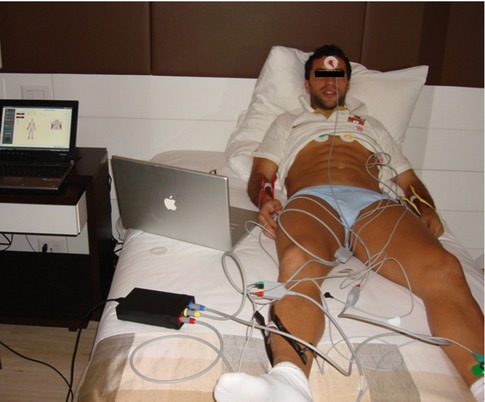

Fig. 5.5
Athlete during Omegawave testing
The system measures brainwave activity to determine how the athlete is adapting to stress of all kinds. It might find that an athlete is recovering quickly and can handle a more intense regimen. Or it might indicate that the body is being overly taxed and needs more rest.
5.3.3 Is Mechanical Overloading Also a Problem?
Under high force and long duration loading, the collagen fibres exhibited high deformation with an increased thickness of the layer of collagen fibres oriented almost parallel to the surface and a cartilage thickness reduced to 54 % [3]. Both overuse and disuse of joints upregulate matrix metalloproteinases (MMPs) in articular cartilage and cause tissue degradation; however, moderate (physiological) loading maintains cartilage integrity [4, 5]. In top athletes, joints surcharge and cartilage degradation can be a handicap, regarding performance, through the years. Besides genetics, load type, frequency and time of exposure, the decrease of proteoglycans and type II collagen and the increase of type I collagen metalloproteinases, isoleucines and nitric oxide can explain the chondrocyte failure and the precocity cartilage degradation in top-level athletes (Fig. 5.6).
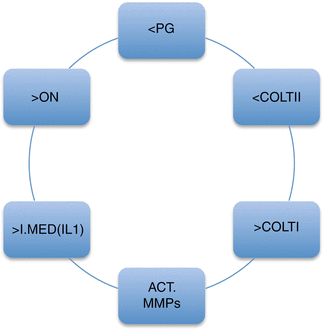

Fig. 5.6
Metabolic joint cartilage changes, in top athlete, in relationship with continuous and vigorous exercise
5.4 Analysis of the Movement Sequence and Neuromuscular Training Programmes
Modern human movement analysis is the interpretation of computerised data that documents an individual’s upper and lower extremities, pelvis and trunk motion during movement. The development and improvement of electronic technology, and computer science, has made it easier to analyse human movement [6].
The increasing involvement of technology in medicine has made some other methods and tools available for tracking and assessing human motion. Additional equipments, such as dynamic EMG, force plates, pedobarographs, electrogoniometers and metabolic analyzers, have made a more complicated but also more complete acquisition of human movement available. Sports performance is directly linked to human motion and performance. So, movement analysis is automatically a part of human performance assessment and analysis.
Today in many sports, sports scientists use movement analysis as a tool to enhance techniques, correct movement errors, assess metabolic costs related to a variety of movements and aid in rehabilitation and prevention.
The deleterious impact of injuries on athlete health and performance has precipitated extensive efforts towards their prevention. In particular, recent research has focused on identifying underlying neuromuscular control predictors, as such factors are readily amenable to training and in essence, preventable, after biomechanic laboratory studies (Fig. 5.7).
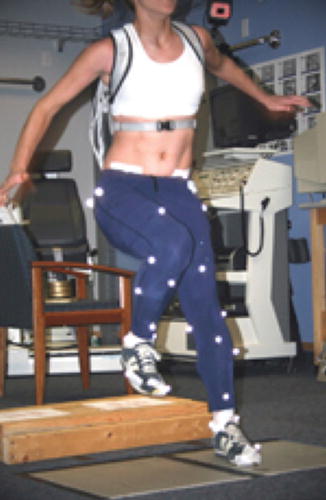

Fig. 5.7
Analysis of movement in laboratory
Neuromuscular training programmes continue to evolve out of this research, which attempt to modify what are considered abnormal and potentially hazardous movement strategies. This in turn would facilitate more effective prevention methods that promote successful neuromuscular adaptation within individual non-modifiable constraints, like individual neuromuscular fatigue profile.
According to the work of Hubsche et al. [7] based on the results of seven high-quality studies, to assess the effectiveness of proprioceptive/neuromuscular training in preventing sports injuries, it seems evident that proprioceptive/neuromuscular training is effective in reducing the incidence of certain types of sports injuries amongst adolescent and young adult athletes during pivoting sports.
5.5 Analysis of Physical Condition
It is widely known that a scientific approach has to be applied for selecting potential athletes and training them for better performance. As a fundamental step for adopting a scientific approach, systematic collection of empirical data and materials are essential. Until now, many sports scientists, in cooperation with sports doctors and physiotherapists, have conducted diverse kinds of research to elucidate various characteristics of elite athletes including morphology, fitness, psychology, behaviour, skills and physical capacity. The majority of these studies were based on the scientific analyses of elite athlete’s physical characteristic fitness status or competition records as shown in Melnikov and Singer [8] work.
The rationale for continuous endeavour of the scientists studying elite athletes who are in the middle of their peak performance stage is in the fundamental hypothesis that a specific mode of athletes’ performance is ideally optimised by their physical characteristics and fitness as well as their psychological status and techniques.
The concept of elite athlete as model of the sports events, in which they are involved, could be related as a profile and a contribution to activities as selecting, training and prescribing athletes, having in mind that physical characteristics such as body morphology and fitness are relatively simple to quantify, and reliable to measure, compared to the other functional parameters, according to Yang and Lee [9].
Normally, a general and major attempt to formulate and clarify physical fitness profiles of the elite athletes was describing and comparing means and standard deviations of each measured variable of a specific event. And analyses of the differences between means were also utilised. However, this profile information may only be useful to compare characteristics amongst athletes of various sport disciplines but have a limitation in providing training guidelines and prescriptive measures for those who are in a beginner’s and developmental stages. To be used as an informative tool applicable for selection of young athletes and training of elite athletes, a profile which can be adoptable for every age group should be formulated. Thus, the standard of comparison for each parameter should be formed by the values which are elicited from the general population that are not elite athletes and are age-matched general counterparts, according to Matsudo [10].
Stay updated, free articles. Join our Telegram channel

Full access? Get Clinical Tree








